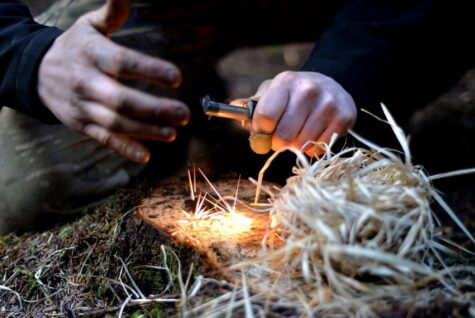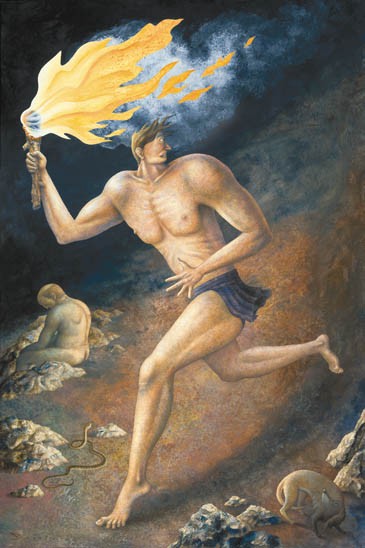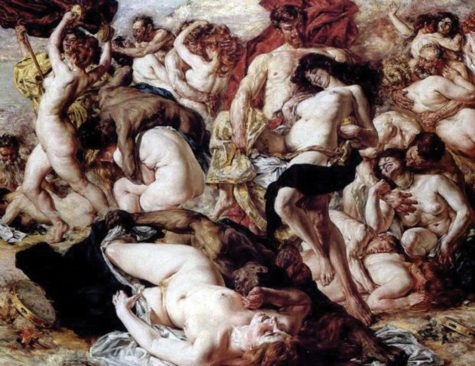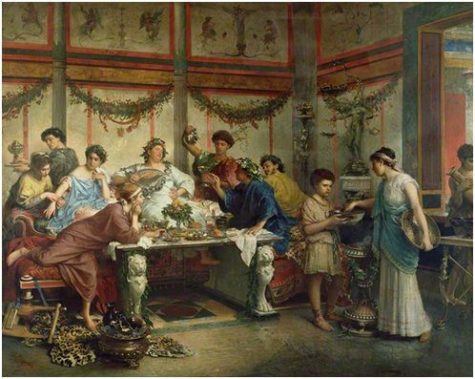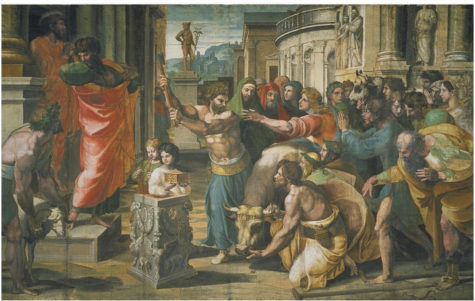Greek Festivals
According to one calendar, the ancient Greeks celebrated the ‘Feast of the Stolen Fire’ on or around November 7. I was unable to find any other mention of it, but I like the idea, so I’m adding it here. I think November is as good a time as any to celebrate the gift of fire.
Alternatively this could be celebrated on the 8th day after the November dark moon. The date will vary from year to year, but since the 8th lunar day is a day for fire, it seems appropriate.
This feast day is held in honor of the old Titan god, Prometheus, who stole fire from the gods and presented it to mortals, thus saving the human race. Many lamps were lit in his honor.
About Prometheus
Prometheus was the Titan god of forethought and crafty counsel who was given the task of molding mankind out of clay. His attempts to better the lives of his creation brought him into conflict with Zeus.
First he tricked the gods out of the best portion of the sacrificial feast, acquiring the meat for the feasting of man. Then, when Zeus withheld fire, he stole it from heaven and delivered it to mortal kind hidden inside a fennel-stalk.
As punishment for these rebellious acts, Zeus ordered the creation of Pandora (the first woman) as a means to deliver misfortune into the house of man, or as a way to cheat mankind of the company of the good spirits.
Prometheus meanwhile, was arrested and bound to a stake on Mount Kaukasos (Caucasus) where an eagle was set to feed upon his ever-regenerating liver (or, some say, heart). Generations later the great hero Herakles (Heracles) came along and released the old Titan from his torture.
For the Greeks and many who followed, Prometheus was revered as a champion of humanity, as well as a bringer of wisdom, reason, and knowledge. In Athens, the center of his ritual observance, Prometheus was credited not only as the bringer of fire, but of metallurgy as well. Alongside Athena and Hephaestus, Prometheus was celebrated by the city as a wellspring of technology, craft, and the civilized arts.
Prometheus is the archetypal figure of revolutionary defiance, chained to a rock with an eagle eating his liver, which regenerates only to be eaten again the next day. The story of Prometheus has mesmerized the imagination of philosophers, painters and poets ever since.
Despite his prominent role in their mythology, Prometheus was seldom worshipped by the ancient Greeks. His cult was limited to Athens, where, alongside Hephaestus and Athena, he served as part of an unofficial triumvirate of deities associated with technology and culture. Artisans, in particular, paid homage to Prometheus, who gave them the gifts of fire and metallurgy.
The Athenians erected an altar to Prometheus in the grove outside the Academy, a key learning center founded by Plato in the fourth century BCE. This altar served as the starting point for a torch race held during the Panathenaic festival, an Athenian civic festival held every four years.
A Ritual In Honor of Prometheus
- Colors: Blue and red
- Element: Air
- Altar: Upon cloth of blue place a great torch, a large and ugly stone with a chain laid over it, and a great curved blade laid against it.
- Offering: Stand up for something that you believe in, even if it will do you harm.
Invocation to Prometheus
Long ago, wars tore the land
And the great and powerful laid waste
To all things, and some won,
and some lost, but the true losers
Were those unfortunate humans
Who were beneath the notice of either side.
One Titan took pity on them,
And tricked the gods who would have
Robbed them of even their food,
And taught them to keep the best part
Of their sacrifices for themselves.
And then, to help them further
In the face of the wrath of the powerful,
He stole fire from the sacred forge
And gave it to weak humanity.
And for this he was punished,
As he knew he would be punished,
Chained to a stone and torn by a vulture.
And yet the knowledge of that punishment
Did not deter him from his goal,
For when there is something that must be done,
And it is right to do it,
Then harm to body and mind
Does not stop right action.
For this we hail Prometheus,
Lord of Forethought,
He who sacrifices for the good of all,
He who knows what it is to be right,
And what will be the consequences.
All stand before the altar and salute the torch, and speak of their own convictions.
A Fire Meditation
This is a day for transformation and purification.
- Purification with fire.
If possible, sit by a woodfire in the evening. Prepare yourself for complete interaction with the fire, concentrating on the flames and slipping into its energy field. Close your eyes and imagine yourself in the center of the fire. Feel how it burns out all your negative emotions and clears your energy channels.
When you feel it’s enough, imagine yourself stepping out of the fire and deeply breathe in the clear fresh air. Your channels are now filled with pure new energy, your aura is light and transparent. Realize that your aura and body have just experienced some new chemical reactions, which renewed your life.
Give thanks to the fire for your purification. If making wood-fire is impossible, practice the same meditation with candles.
Making Fire
The following is an article about starting a fire from scratch when you are camping out in the woods. I thought it would be a fun and interesting way to celebrate Prometheus and his gift of fire. Enjoy!
Hopefully, you’ll never be in the position where you won’t have any matches or lighters to start a fire with when you need one. However, no matter how cautious you are about taking fire-making instruments with you, it’s good to know more than one way to start a fire when you spend a lot of time in the great outdoors.
For example, if you’re caught in an unexpected thunderstorm, your matches might get wet, despite your best efforts to keep them in a waterproof container. Since anything can happen, be prepared for anything. Here are six ways you can start a fire without a match.
- 1. Always carry tinder.
Starting a fire from scratch is difficult enough even with matches. Without matches, it’s even harder. To give yourself a head-start on starting a fire, bring a tinder kit with you.
A tinder kit should consist of material that is dry and easy to use in the creation of a fire. You can tease apart rope fiber into soft, thin threads; cotton balls soaked in Vaseline work especially well; and you can always buy tinder kits.
If you’re caught without any tinder material on you, or if what you have has gotten wet, look for cedar trees or birch trees. The bark of these trees can be shredded to create some quick tinder. Cattails also work as natural tinder material.
- 2. Using Flint and Steel
One of the easiest match-free ways to start a fire is to use flint and steel. Flint and steel kits can be purchased relatively inexpensively and are easy to start a fire with if you have a tinder kit, especially if your tinder kit includes charcloth.
Making a fire with flint and steel has three essential steps: First, you need to create a spark. Second, you need to catch that spark. Third, you need to turn the spark into a flame.
To complete the first two steps, take a small bit of charcloth and lay it flat against the flint. Next, strike the flint with the metal striker. You should see sparks immediately if you strike the flint at the right angle.
One of these sparks should eventually land on the charcloth, giving it a tiny orange glow. That tiny glow is enough to start a fire with; you should transfer the charcloth to the tinder nest when the glow appears, gently wrapping the charcloth into the tinder nest and then blowing on it.
The tinder nest should smoke and produce a flame almost right away. You can feed the flame with small kindling, such as dried grass, pine-straw, or twigs, and then use the more stable flame to light your logs on fire.
- 3. Using a glass lens.
Some of us discovered this method quite on accident as children when we melted toys with a magnifying glass or accidentally caught bugs on fire. Hopefully, you won’t be using your magnifying glass to torture bugs when you’re on your next hiking trip, but if you have an unobstructed view of the sun, you can easily use the magnifying glass method to start a fire.
A magnifying glass that rotates in and out of a vinyl case, as opposed to a magnifying glass with a handle, is ideal for traveling with.
This method is very simple. Put your tinder nest on the ground or with your kindling, then aim the beam of the sun at the tinder nest until it begins to smoke. When it starts smoking, gently blow on the tinder nest until you produce a flame.
Using a magnifying glass to start a fire is easy, but it depends upon having a decent amount of sunlight. Since you can’t always depend on the sun being out, it’s good to have more methods on-hand than just the magnifying glass.
- 4. Capture the rays of the sun.
Besides using a glass lens to capture the rays of the sun and produce a fire, you can also use a water-filled balloon or a mirror to achieve the same effect. When using water inside a balloon, try to make the shape into a sphere. The more spherical the container is, the more effective it will be at focusing the rays of the sun.
If you don’t have a mirror on hand, you can polish the bottom of a soda/beer can with toothpaste or chocolate and turn it into a mirror. By the way, if you use this last method, don’t eat the chocolate after you’ve polished your aluminum can with it; the chocolate may contain toxic residue.
- 5. Use friction.
One of the most famous ways to start a fire without a match is also one of the most difficult: using friction. To use this method, make a v-shaped notch in a board or log, and choose a spindle that will create the friction.
Rub the spindle between your hands as fast as you can, moving your hands up and down the spindle rapidly. When the board or log begins to smoke, use your tinder nest to catch the glowing spark you’ve produced.
You can also create a bow drill instead. The bow drill is easier than the primitive method described above, but it requires you to make a proper bow first, which is harder.
- 6. When it’s wet outside.
What if you’re in a worst-case scenario type of situation? Your matches and your lighter have both gotten wet and won’t work. You have a tinder kit, along with some flint and steel, but your tinder kit has gotten wet, too. The downpour has also made the forest around you wet, so there is virtually no dry kindling or logs anywhere to be found.
Are you stuck at this point? No. If you’re resourceful, you can still start a fire.
Start by finding some dry tinder. The aforementioned birch or cedar bark works well in this scenario, but you’ll have to peel a few layers of bark off to get to the dry bark.
As for finding dry wood, look for a standing dead tree. Unlike a dead tree that’s lying on the forest floor, a standing dead tree will usually be dry inside. Peel away the rotted, wet, outer section of the tree to get to the dry wood on the inside.
You can use this dry wood as your kindling. Once you have a decent blaze going, you can use even damp limbs and twigs in your fire, because the heat of the fire will be strong enough to catch damp wood at that point.
Stealing Fire
Fire is a very powerful symbol, human progress did not begin until we established fire. The gift of fire opened the door to so many things such as cooking our food, melting metals, and providing warmth in the winter. It represents the start of civilization, consciousness, new ideas, and symbolizes man’s development of art and technology with its promise to better our lives, but not without respect for it and the gods.
Most cultures with a story to tell about fire’s origin see it as a theft. Fire is stolen, from someone who does not want to share it. Sometimes by a bird or animal blazoned with red because the fire left a scar.
Why have people always felt that fire was stolen? There’s a simple material explanation: earth, water and air, the other traditional elements of the world, are around us all the time but fire must be coaxed out of wood and stone, unless it comes down as lightning, as divine fire. Fire also needs special knowledge. You have to learn to kindle and nurture it, so it won’t go out. This knowledge must be guarded so the secret won’t be lost.
The theft of fire for the benefit of humanity is a theme that recurs in many world mythologies:
- Africa
The San peoples, the indigenous Southern African hunter-gatherers, tell how Kaggen, in the form of a mantis, brought the first fire to the people by stealing it from the ostrich, who kept the fire beneath its wings.
- Native America
Among various Native American tribes of the Pacific Northwest and First Nations, fire was stolen and given to humans by Coyote, Beaver or Dog. In Algonquin myth, Rabbit stole fire from an old man and his two daughters.
In Cherokee myth, after Possum and Buzzard had failed to steal fire, Grandmother Spider used her web to sneak into the land of light. She stole fire, hiding it in a clay pot.
According to a Mazatec legend, the opossum spread fire to humanity. Fire fell from a star and an old woman kept it for herself. The opossum took fire from the old woman and carried the flame on its tail, resulting in its hairlessness
According to the Muscogees/Creeks, Rabbit stole fire from the Weasels. In Ojibwa myth, Nanabozho the hare stole fire and gave it to humans. According to some Yukon First Nations people, Crow stole fire from a volcano in the middle of the water.
- Eurasia
According to the Rigveda, the hero Mātariśvan recovered fire, which had been hidden from humanity.
In one of the versions of Georgian myth, Amirani stole fire from metalsmiths, who refused to share it – and knowledge of creating it – with other humans.
The Vainakh hero Pkharmat brought fire to mankind and was chained to Mount Kazbek as punishment.
- Oceania
In Polynesian myth, Māui stole fire from the Mudhens. In the mythology of the Wurundjeri people of Australia, it was the Crow who stole the secret of fire from the Karatgurk women.
Sources:
The festival of Nemoralia (aka Festival of Torches) was celebrated by the ancient Romans either on 13–15 August or on the August Full Moon, in honor of the goddess Diana (Diana Nemorensis). This festival was later adopted by Catholics as The Feast of the Assumption.
Ovid describes the celebration thus:
“In the Arrician valley, there is a lake surrounded by shady forests, Held sacred by a religion from the olden times… On a long fence hang many pieces of woven thread, and many tablets are placed there as grateful gifts to the Goddess. Often does a woman whose prayers Diana answered, With a wreath of flowers crowning her head, Walk from Rome carrying a burning torch… There a stream flows down gurgling from its rocky bed…”
On this day, worshippers would form a shimmering procession of torches and candles around the dark waters of Lake Nemi, Diana’s Mirror. The lights of their candles join the light of the moon, dancing in reflection upon the surface of the water. Today’s festival is held in the Greek fashion.
Hundreds join together at the lake, wearing wreaths of flowers. According to Plutarch, part of the ritual (before the procession around the lake) is the washing of hair and dressing it with flowers. It is a day of rest for women and slaves. Hounds are also honored and dressed with blossoms. Travelers between the north and south banks of the lake are carried in small boats lit by lanterns. Similar lamps were used by Vestal virgins and have been found with images of the Goddess at Nemi.
One 1st century CE Roman poet, Propertius, did not attend the festival, but observed it from the periphery as indicated in these words to his beloved:
“Ah, if you would only walk here in your leisure hours. But we cannot meet today, When I see you hurrying in excitement with a burning torch To the grove of Nemi where you Bear light in honour of the Goddess Diana.”
To Do Today
Requests and offerings to Diana may include: small written messages on ribbons, tied to the altar or to trees; small baked clay or bread statuettes of body parts in need of healing; small clay images of mother and child; tiny sculptures of stags; dance and song; and fruit such as apples.
In addition, offerings of garlic are made to the Goddess of the Dark Moon, Hecate, during the festival. Hunting or killing of any beast is forbidden on Nemoralia.
Source: Wikipedia
Aphrodisia, festival of Aphrodite, ancient Greece was, according to Wilson’s Almanac celebrated on or around February 6th. If you’d like to invoke the Goddess of love, sex, and beauty, you can prepare for a feast honoring Aphrodite’s loving sensuality and warmth.
- Decorate with pink carnations; they are the flowers of friendship.
- Burn warm yellow sandalwood scented candles – sandalwood loosens inhibitions.
- Put symbols of love including pomegranates, apples, and seashells out in blue ceramic or crystal bowls.
- Invite friends to bring an aphrodisiac food for sharing (cherries, oysters, papaya, chocolate, truffles, red wine, etc).
- Open a window or door slightly.
- Join hands around the dinner table.
Recite this invocation:
Aphrodite, Greek goddess of friendship, love, and life
Come join us, bring peace and eliminate all strife
We welcome you with fruit, flowers, fire, and fresh air
Release us from anxiety, stress, or despair
Come down; be with us
Grace us this special day
We call you with love
We hope you will stay.
Repeat three times with sincerity.
Who is Aphrodite?
Aphrodite is the Olympian goddess of love, beauty, sexual pleasure, and fertility. She is regularly attended by few of her children, the Erotes, who are capable of stirring up passion in both mortals and gods at the goddess’ will.
Portrayed as both insatiable and unattainable, Aphrodite was born near the coast of Cythera out of the foam (aphros) Uranus’ castrated genitals created when they fell into the sea. Even though married to Hephaestus, she had affairs with all Olympians except Zeus and Hades, most famously with Ares, the god of war. She also had famous romances with two mortals, Anchises and Adonis.
A Ritual for The Aphrodesia
- Colors: Sea green and white
- Element: Water
- Offerings: Shells. Fishes. Promises to aid expectant parents.
- Daily Meal: Ocean fish. Shellfish. Sweet things, especially desserts. Whipped cream.
Altar:
Lay with a cloth of sea green, strings of pearls, white lace, many scallop shells, colored glass sea floats, abalone, small shells with hearts and fishes painted on them, and a large chalice of Greek wine with frothy sugared egg whites floating in it.
Invocation to Aphrodite Genetrix
Lady of Sea-Foam,
Green as the ocean from which
You sprang, with pearls
Of whitest foam,
Aphrodite Genetrix
Love that creates all Life,
We thank you for the Love
That sparked our existence.
We remember that we were all born of love
Whether it was brief and poignant
As a firefly’s courtship
Or solid and lasting
For half a century,
Whether it sprang from the body
Or the heart, or the soul.
You who bind the proton to the electron
And so bind the world together,
May we never forget your gift of attraction
That makes us all human
Even as you are divine.
Chant:
Amor Invictus
Amor Invictus
The ritual for this day is the Great Rite, performed by one man and one woman, as Aphrodite Genetrix is the matron of procreative sexuality. If done symbolically, the man plunges a blade into the chalice held by the woman, and then it is poured as a libation.
Ideally, it should be done literally, either by members of the house or by two who have come in for this purpose. If outsiders, it would be an auspicious time to conceive a child. All sit facing outwards in a circle and chant as the couple are wrapped in a red cloth and lay together in the center, and when it is done all repair to their rooms and either contemplate love or have ritual sex, alone or together.
Sources:
There is not a lot of information about this particular feast day and the dates given for it vary widely. Our calendar lists it as January 30 – 31, but some calendars assign it to January 17 – 18, others say April 18 – 19, May 26, July 9 – 10, or October 13. None of these calendars have any information other than that it is called “Feast of Charities” for the Greek goddesses known as the Graces. I don’t think anyone really knows much about it.
I did find a Feast of the Charities Ritual at Llewellyn. Here it is:
- Color of the day: Orange
- Incense of the day: Sage
Today is the Feast of the Charities. These old Greek goddesses of beneficence were known to the Romans as the Gratiae, or “Graces.” They are Aglaea, whose name means “splendor,” Euphrosyne, or “joy,” and Thalia, or “mirth.” The Charities bestow charm, beauty, and creativity on their worshipers. In this regard they serve a similar purpose to the nine Muses. Generosity and festive activities please these goddesses.
- Get some friends together and dress up.
- Arrange each other’s hair.
- Dance and sing, or perform some sacred theater.
- Visit an art gallery or walk through a street fair.
Alternatively, do something nice for the less fortunate. Bundle up old clothes you never wear anymore to recycle for the less fortunate, or hold a food drive and donate the results to a local charity. (Yes, the term comes from the name of these goddess, “Charities.”) You could also donate your money or time. Give of yourself, and you shall receive “grace” from the Charities in return. Be kind and giving, and your creativity will overflow!

Agathos Daimon means “good spirit” and is a religious observance held on the second day of each lunar month, immediately following the Noumenia. It is the third celebration of a trio of household monthly observances. A good spirit usually refers to a type of divine being that is less powerful than a God, is personal to each family, and can bring the family good luck, protection, or some type of assistance. Household spirits are usually seen as either snakes or as a young man with a horn of plenty in hand.
More about this spirit can be found at The Powers That Be:
Some celebrate the Agathos Diamon by pouring a libation to the spirit and asking for his continued blessings on the family. If there is something in particular that your family wishes help with, give an additional offering to your family’s protective spirit. Although we know we can always approach the Gods directly, the Agathoi Diamones are seen to be helpful intermediaries between the Gods and man.
The second day of every Athenian month was also a sacred day, devoted to the Agathos Daimon (good spirit). The name daimon does not mean the evil demon of modern Christianity, (although it did have a negative form, called the kakodaimon), but was thought to be an aspect of Zeus, as Zeus Ktesios, Charitodotes, and Epikarpios, titles as giver of increase and joy.
Agathos Daimon is most often represented in the form of a snake, a symbol of healing. However the daimon is also a function of one’s being, a characteristic inherently neither good nor bad. The philosopher Sokratēs talks of his own daimon as a small voice which speaks to him and warns him to refrain from certain actions.
Hence, one prays for a good daimon, an eudaimon, and goodness from the gods for the coming month and also for the favor of father Zeus as Agathos Daimon.
- One must be on good terms with it. ~Burkert.
- The daimon active about me I will always consciously put to rights with me by cultivating him according to my means. ~Pindar
- The great mind of Zeus steers the daimon of the men whom he loves. ~Pythagoras
Many modern Hellenes follow the practice of pouring a libation to their own Agathos Daimon on the second day of the lunar month. Possible prayers include the Orphic Hymn to the Daimon.
Thee, mighty-ruling, Dæmon dread, I call, mild Zeus, life-giving, and the source of all:
Great Zeus, much-wandering, terrible and strong, to whom revenge and tortures dire belong.
Mankind from thee, in plenteous wealth abound, when in their dwellings joyful thou art found;
Or pass through life afflicted and distressed, the needful means of bliss by thee suppressed.
‘Tis thine alone endowed with boundless might, to keep the keys of sorrow and delight.
O holy, blessed father, hear my prayer, disperse the seeds of life-consuming care;
With favoring mind the sacred rites attend, and grant my days a glorious, blessed end.
Aeschylus in the Suppliant Maidens says: “May Zeus grant that it go well with us. For Zeus’ desire is hard to trace: it shines everywhere, even in gloom, together with fortune obscure to mortal men.” Kleanthēs prays: “Lead me, O Zeus, and thou O Destiny” and also, “If so it pleases the Gods, so let it be.”
Agathos Daimon is also associated with Dionysos, especially with His gift of wine. A feast was often closed with a small drink of unmixed wine, called either Agathos Daimon or Zeus Soter (savior), as though supplicating the god that they may do nothing indecent or have too strong a desire for the drinking, and may receive from it all that is noble and salutary.
Also, whenever you see a snake, give a prayer to Agathos Daimon and even pour a libation. In Hellenistic and Roman times, family ritual areas were often decorated by snakes.
Source: Hellenion
The Noumenia is the first day of the visible New Moon and is held in honor of the household Gods. The Noumenia is also considered the second day in a three day household celebration held each lunar month – Hekate’s Deipnon is on the last day before the first slice of visible moon and is the last day in a lunar month, then the Noumenia which marks the first day in a lunar month, followed by the Agathos Daimon (Good Spirit) on the second day of the Lunar month.
The Noumenia is a celebration of the start of a new Hellenic month and seeks blessings for the household. Offerings such as incense or honey cakes are made to your household Gods at your family altar.
- Here’s a recipe for Ancient Hellenic Honey Cakes.
Traditionally, the household Gods consist of Hestia, Zeus Ktesios, Hermes, Hekate, Apollon Agyieus, your household’s Agathos Diamons and can include any ancestors you honor. However, many Hellenic Polytheists do honor more Gods at their family altar.
You can celebrate the Noumenia with the following rituals:
- Decorate their home with fresh flowers, evergreen branches, or other seasonal decorations.
- Serve a big family meal and eat it at the dining room table.
- Create a list of family goals or projects to get done or start within the next lunar month.
- Bake a special dessert that you only make on this day – such as Honey Cake.
- Like the ancient Athenians, you can burn frankincense and read the Orphic and Homeric hymns to Selēnē.
- Replace the ingredients in the Kadiskos (see below) with fresh water, oil, and fruit, and bits of food.
The Kadiskos is a small jar containing food stuffs that we receive from the Gods and give back in reciprocity. Refreshing the Kadiskos is part of preparing for Noumenia. Here are directions for Making a Kadiskos.
Hellenic Worship:
Hellenic worship makes notice of the New Moon, because it marks the beginning of the month, rather than the more obvious full moon, although many Hellenic festivals are held during or near the time of the full moon.
“The first day of the month was new moon day (noumēnia), recognized as a holy day throughout the Greek world. It was so holy that at Athens, no other festival ever took place that day. It was celebrated by a public ritual on the Acropolis and by private offerings of frankincense to statues of the gods.”
Herodotus says that, in Sparta, meat, barley meal and wine were distributed to the citizens by the Kings on the Noumenia.
Hymn To Selene
Orphic Hymn 9 to Selene says that she “Delights in stillness and in the kindly, auspicious night.” Many of the Orphic hymns, and this one especially, reminds us that the arrival and passage of each new month is a reflection of the cycle of lives, with birth following the period of dark death. So as She is “a sure token and a sign to mortal men,” so we can trust in the cycle of rebirth and renewal.
Orphic Hymn 9 ~
Fumigation from Aromatics
Hear, goddess queen (thea basileia), diffusing silver light, bull-horned, and wandering through the gloom of night.
With stars surrounded, and with circuit wide night’s torch extending, through the heavens you ride: female and male, with silvery rays you shine, and now full-orbed, now tending to decline.
Mother of ages, fruit-producing Mene (Moon), whose amber orb makes night’s reflected noon: lover of horses, splendid queen of night, all-seeing power, bedecked with starry light, lover of vigilance, the foe of strife, in peace rejoicing, and a prudent life: fair lamp of night, its ornament and friend, who givest to nature’s works their destined end.
Queen of the stars, all-wise Goddess, hail! Decked with a graceful robe and amble veil.
Come, blessed Goddess, prudent, starry, bright, come, moony-lamp, with chaste and splendid light, shine on these sacred rites with prosperous rays, and pleased accept thy suppliants’ mystic praise.
More Hymns, Prayers, and Invocations can be found at Widdershins.
A Prayer For The Noumenia
In honor of the Noumenia of Anthesterion:
I have seen the moon
thin curved glow
hovering on delicate breeze
divine above the pink horizon
gentle horns pointing
toward tomorrow
We are all re-born now
owning no past
Yesterday is cleansed
complete
Greetings to you,
Goddess!
Guide us around
the next cycle of life
until we meet again
May we use it wisely
~ by Melissa
Source: Hellenion.org
Nowadays, whenever we hear the term Bacchanalia getting thrown about it is typically used to describe wild partying that has gotten way out of control. In the popular imagination, the Bacchanalia are often characterized by frantic participants moshing together in a pit of sexual orgies.
The Bacchanalia were free-spirited and sexually charged festivals that involved pagan mysticism, wild sex and divine communion which allowed its celebrants’ to achieve states of euphoria that hovered between divine ecstasy and the oblivion of nothingness. Those who have spent a week at one of the Hedonism resorts in Jamaica would probably find the sexually charged atmosphere of the Bacchanalia remarkably familiar.
The cult of Bacchus was a mystery religion that originated in Asia Minor (modern day Turkey) and spread throughout Greece and into southern Italy where it became extremely popular among the Romans. Despite their notoriety, not much is known about the Bacchanalia. This is largely due to the fact that mystery religions were closed to the uninitiated and their inner-workings kept secret from the outside world. However, scholars have managed to piece together fragments from ancient legal documents, historical texts and plays that can help give us a glimpse into the bacchanalian festivities.
The Bacchanalia first appeared in Greece around 700 BC and eventually found their way into Italy around the fourth century BC. The first bacchanals were held twice yearly in the middle of winter and were reserved for girls and women who performed their rites naked. By the time Rome had become the preeminent power in the Mediterranean after their victory over Carthage in the Second Punic War (202 BC), the rituals had opened up considerably making them quite popular with the natives.
Admission was extended to men and people of all social classes; even slaves could even join in on the fun. With the increased popularity, celebrations were taking place as often as five times a month.
The time and location of the bacchanals were usually closely guarded secrets. Priests and priestesses preferred to hold their gatherings in secluded forests where their privacy could be ensured. On the day of the festival, devotees would prepare some goats by painting their horns gold. Special torches dipped in sulphur and charcoal was also made. Devotees often wore fawn skins that emulated forest animals. Skimpy outfits or even complete nudity was also par for the course. Participants would often carry along their favorite sex toy; women would bring sexy wands while men might bring along a wooden phallus.
After nightfall celebrants would proceed to a forest clearing by dancing to the sounds of crashing cymbals and loud music. Once the celebrants arrived at the appointed place, they could be seen quaffing down wine, dancing, leaping, whirling, screaming and generally working themselves up into a frenzied state. They would inspire each other into ever greater acts of ecstasy, whereby the whole scene would descend into a writhing mosh pit of sexual orgies.
The aim was to achieve a heightened state of ecstasy in which the devotee’s souls would be temporarily freed from their physical existence. It was in these moments that the worshipers hoped to commune with Bacchus and obtain a glimpse of what they would someday meet in the afterlife after their resurrection.
The festival would reach its climax with frantic feats of strength and ecstasy, such as ripping trees out of the ground and eating the raw flesh of their sacrificial animals. The latter act was a sacrament similar to communion where the devotees assumed the identity of Bacchus. By symbolically drinking his blood and eating his body, the devotees believed they became one with Bacchus.
The euphoric devotees would then rush over to the banks of a nearby river with their flaming torches and dip them into the water. Since their torches were made with sulfur and charcoal, they would emerge from the water still burning, a symbol of Bacchus’s power.
Source: The Bacchanalian
According to various sources, February 26 is Hygeia’s Day. I did not, however, find any specific rituals associated with the Goddess Hygeia. However, because bathing is so fundamental to basic hygeine, and Hygeia is the goddess of Healing and Hygeine, a healing ritual bath seems appropriate.
Healing Ritual Bath
Take a lit silver or white candle, some salt, and a healing oil (such as carnation, violet, sandalwood, or narcissus) into the bathroom. By the candle’s light run a tub of very warm water. Cast some salt into it, add a few drops of healing oil, and then step into the tub.
Relax. Feel the warm salted water sinking into your pores, through your skin, sterilizing the sick or unhappy portions of your body.
Visualize any illness or bad feelings as “black worms” leaving your body. When you feel the water teeming with them, pull the plug and let the water drain out. While it is draining, chant:
The sickness is flowing out of me.
Into the water, down to the sea.
Only when the tub is completely drained stand up. It is best to immediately splash your body with fresh water (a shower is ideal) to remove the last vestiges of the disease of sickness-laden water. Repeat as needed to speed your body’s recovery.
From: Earth Power
Anthesteria, held on February 11th, celebrates the maturing of the wine and the beginning of spring. It’s an Athenian festival in honor of Dionysus, god of the grape harvest, winemaking, and wine. The celebration lasted for three days in the month of Anthesterion (from the Hellenic calendar in ancient Attica).
The word Anthesteria is associated with “flower” or the “bloom” of the grape. A. W. Verrall (Journal of Hellenic Studies, xx., 1900, p. 115) wrote that it was a feast of “revocation” where the dead were recalled to the land of the living.
In ancient Greece, Anthesteria was the name of a festival during which the participants ritually expelled the Keres, evil female spirits, from their houses.
- The First Day
On the first day, called Pithoigia (opening of the casks), wine from the newly opened casks was offered to Dionysus and everyone in the household, including servants and slaves. The home and children were adorned with spring flowers.
- The Second Day
The second day, named Choës (feast of beakers), was for visiting. People dressed for the day, some even dressed as Dionysus. They spent the day visiting friends and family as well as the local drinking clubs were drinking games were held. Some folks offered wine to deceased relatives by pouring libations on the their tombs.
For the state, however, if was a formal day with secret ceremonies in one of the sanctuaries of Dionysus. The basilissa (or basilinna), wife of the archon basileus, would marry the god of wine in a special ceremony. She was assisted by fourteen Athenian matrons, called geraerae, who the basileus chose and swore to secrecy.
Both Pithoigia and Choës were considered unlucky and defiled days that necessitated atoning with libations. From this the souls of the dead would come up from the underworld and walked the earth. People chewed on buckthorn leaves and smeared tar on their doors to protect themselves from evil.
- The Third Day
The third day, Chytri (feast of pots), was a festival of the dead. Cooked legumes were offered to Hermes, son of Zeus, and he would make the souls of the deceased depart.
Sources:
The 23rd of August marks the Ancient Greek holiday of Nemesia, – the festival of the Goddess Nemesis – the Goddess of Fate, Revenge, and Divine Retribution. Blood sacrifices were traditional on this day.
- Note: According to some sources the Nemesia fell on August 21.
This purpose of this festival was to ‘avert the nemesis of the dead’ in order that they could steer away the suffering or punishment of the living.
The goddess Nemesia, very basically, is the Spirit of Retribution against one’s own arrogance before the gods. Because she had this dual-nature, being both fortune and retribution, the Cults would celebrate in her honor to make sure they did not face her fury and could indeed have the gifts of fortune bestowed upon them. In many cases, she was worshiped by generals and gladiators who would pray for strength in combat. But surely this was not all.
She was invoked against those whose hubris and arrogance got the better of them, and served as a force of divine reckoning. She also appears in both Greek and later Roman mythology as an avenging force protecting those who have been violently wronged by their lovers. During the Imperial period of Rome, Nemesis was adopted as a patroness of victorious generals, and of gladiators entering the arena.
The Cult of Nemesia was later associated with Fortuna in Imperial Rome, the cult of Nemesis-Fortuna, which honored Nemesis as the deliberate balance to the random chance of Fortuna’s selections.The all-powerful Nemesia-Fortuna was worshiped by the Freemen of Hadrian and was considered to have a dual-nature about her.
This dual-nature in Nemesia is something which seems to me symbolic of our human nature. We have this spirit of fortune but also this spirit of retribution within us. At least I do.
Sources: State of Information and Pagan Wiccan





